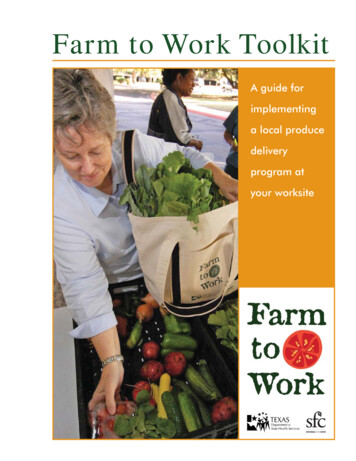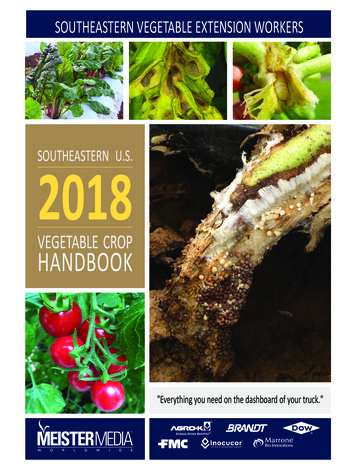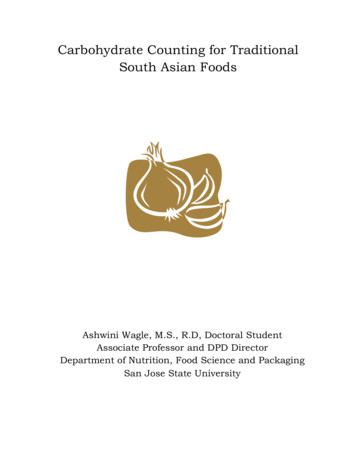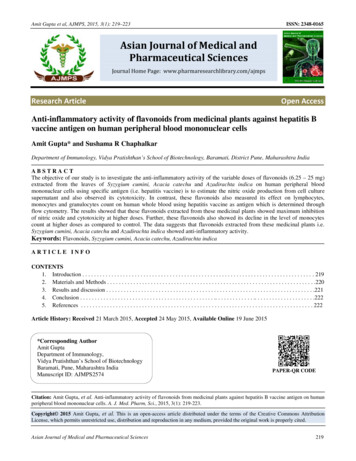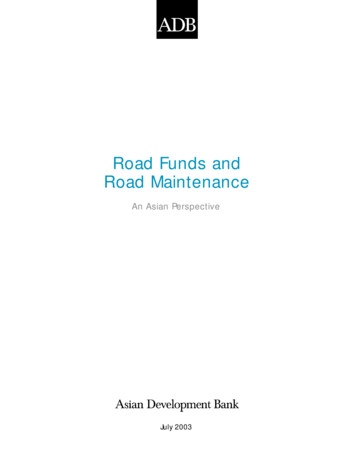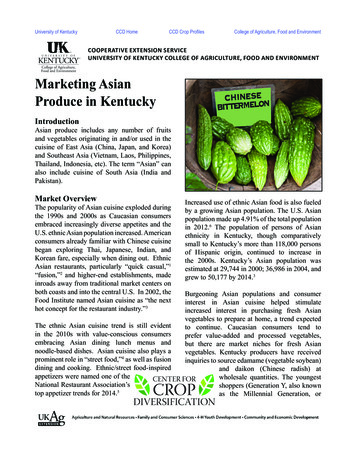
Transcription
University of KentuckyCCD HomeCCD Crop ProfilesCollege of Agriculture, Food and EnvironmentCOOPERATIVE EXTENSION SERVICEUNIVERSITY OF KENTUCKY COLLEGE OF AGRICULTURE, FOOD AND ENVIRONMENTMarketing AsianProduce in KentuckyIntroductionAsian produce includes any number of fruitsand vegetables originating in and/or used in thecuisine of East Asia (China, Japan, and Korea)and Southeast Asia (Vietnam, Laos, Philippines,Thailand, Indonesia, etc). The term “Asian” canalso include cuisine of South Asia (India andPakistan).Market OverviewThe popularity of Asian cuisine exploded duringthe 1990s and 2000s as Caucasian consumersembraced increasingly diverse appetites and theU.S. ethnic Asian population increased. Americanconsumers already familiar with Chinese cuisinebegan exploring Thai, Japanese, Indian, andKorean fare, especially when dining out. EthnicAsian restaurants, particularly “quick casual,”1“fusion,”2 and higher-end establishments, madeinroads away from traditional market centers onboth coasts and into the central U.S. In 2002, theFood Institute named Asian cuisine as “the nexthot concept for the restaurant industry.”3The ethnic Asian cuisine trend is still evidentin the 2010s with value-conscious consumersembracing Asian dining lunch menus andnoodle-based dishes. Asian cuisine also plays aprominent role in “street food,”4 as well as fusiondining and cooking. Ethnic/street food-inspiredappetizers were named one of theNational Restaurant Association’stop appetizer trends for 2014.5Increased use of ethnic Asian food is also fueledby a growing Asian population. The U.S. Asianpopulation made up 4.91% of the total populationin 2012.6 The population of persons of Asianethnicity in Kentucky, though comparativelysmall to Kentucky’s more than 118,000 personsof Hispanic origin, continued to increase inthe 2000s. Kentucky’s Asian population wasestimated at 29,744 in 2000; 36,986 in 2004, andgrew to 50,177 by 2014.3Burgeoning Asian populations and consumerinterest in Asian cuisine helped stimulateincreased interest in purchasing fresh Asianvegetables to prepare at home, a trend expectedto continue. Caucasian consumers tend toprefer value-added and processed vegetables,but there are market niches for fresh Asianvegetables. Kentucky producers have receivedinquiries to source edamame (vegetable soybean)and daikon (Chinese radish) atwholesale quantities. The youngestshoppers (Generation Y, also knownas the Millennial Generation, or
Millennials) are also highly receptive to ethniccuisine.— Mandarin and Cantonese, Korean, Thai,Japanese, and so on.Market OpportunitiesCustomers can then be presented with a copy ofthe farm’s policies, enabling easier enforcementof those rules. It is important that all customershave an understanding of the farm’s rulesgoverning the pick-your-own operation.The U.S. ethnic foods market, including freshproduce, is projected to reach 2.7 billion in2015.7 Smaller growers and market gardenershave immediate opportunities to tap into localconsumer demand for Asian vegetables. Growersshould investigate adding traditionally Asianvegetables to their farmers market offering,community supported agriculture (CSA) shares,or roadside stand mix.Marketing Asian vegetables to restaurants may bepromising for farmers located nearer metro areas.Selling Asian vegetables to upscale restaurantsexpanding their menus to include Asian-themedentrees may also be an option. As with any newmarket, the best way to determine what to growis to find out what the customer wants. This isespeciallycriticalin finding nichemarkets for Asianvegetables,wherevarious ethnic groupsmay prefer differentsizes, colors, andother characteristicsof the same eggplant,radish,cucumber,etc. Growers shouldAsian Eggplantrecognize that thesedifferences extend torestaurants, with distinctions in produce sourcedby Thai, Chinese, Indian, Japanese, and otherethnic chefs.Pick-Your-Own (U-Pick)Pick-your-own (PYO) marketers always facethe challenge of communicating their farmpolicies and picking rules to their customers.PYO marketers selling larger amounts ofproduce to non-native English speakers shouldconsider having their farm policies translatedinto languages common to their customersOpen communication lines with your customerscan also result in additional markets for otherproducts. While welcoming guests to the farmand explaining PYO rules, producers can asktheir customers what other products they mightbe interested in purchasing. This can help theproducer discover new crops to offer at the farmmarket.Asian Pears and MelonsKentucky orchardists near Lexington, Louisville,and Cincinnati have found a ripe local marketfor Asian pears (also called “pear apples”).Orchardists report that Asian customers enjoyobtaining fresh Asian pears at the farm andhave been especially open to pick-your-ownoperations. On a smaller scale, some producershave successfully marketed specialty Asianmelons near these metro areas.Asian VegetablesKentucky growers could potentially discoverlocal market niches for dozens of Asianvegetables. The challenge to the grower is toidentify those vegetables that may be grownefficiently and readily marketed. Using fundsfrom a University of Kentucky New CropOpportunities Center marketing project, severalproducers were provided seed for kabocha squashin 2004. Kabocha squash, also called Japanesepumpkin, is a hard (winter) squash well-receivedby both ethnic Asian and Caucasian consumers.It was selected because of the availability of pastUniversity of Kentucky variety trial research.Kabocha squash customers were surveyedabout their Asian vegetable buying practices
and preferences. Their responses reinforcedbasic guidelines for direct marketing specialtyvegetables. Key considerations for producerswishing to develop market niches for Asianvegetables are: Provide preparation instructions andrecipes at purchaseBundle specialty vegetables with otherproducts and provide instructions for useProvide educational information aboutthe vegetable’s name, where and how itis grown, and other backgroundinformationfarm market in 2004.Other vegetables that the kabocha squashcustomers said they were willing to purchase wereceltuce/asparagus lettuce, chayote, garlic chives,wax gourd, and Japanese eggplant. The samplesize of this survey is too limited for producersto make assumptions that these vegetables willbe popular in their areas. Producers should usethe sample survey instrument (see Appendix I) orother basic market research to develop their owntools for measuring interest and market nichesfor new crops.It is a proven marketing practice to includerecipes with specialty crop purchases. Evencustomers already familiar with kabocha squashwere interested in receiving recipes at purchase.Producers can obtain recipes from a variety ofsources, and should always verify that the recipemay be reproduced and distributed.Recommended Asian Vegetable MixFor New GrowersA recommended Asian vegetable mix for growersinterested in experimenting with Asian crops islisted below. These are the more common ethnicAsian produce items demanded by farm marketand farmers market customers in Kentucky. Specialty greens and herbsBok choyDaikonSpecialty cucumbersSpecialty eggplantsSpecialty melonsSpecialty squash/gourdAccording to the Kentucky Produce Marketingand Planting Intentions Survey, Asian vegetablesmost likely to be grown by commercial vegetablegrowers in Kentucky are bok choy, daikon,eggplant, and Asian greens. These were also thevegetables most likely to be purchased by thekabocha squash customers surveyed at an on-Asian Vegetable Name ChartThe following chart (Appendix II, Table 1)is a partial reproduction of a listing of Asianvegetables and their ethnic names in theUniversity of California’s Specialty and MinorCrops Handbook. It has been reproduced bypermission. The handbook is recommended forthose interested in Asian crops, as well as otherspecialty produce. Other Asian vegetables thatcould potentially be grown in Kentucky are listedin a second table (Appendix II, Table 2).Selected Resources Asian Vegetables (University of asian.pdf Asian Vegetables (Midwest VegetableProduction sianVeg.pdf
Growing and Marketing Chinese Vegetablesin Central Kentucky (University of Kentucky,1996) /v3-496.html Kentucky MarketMakerhttp://ky.foodmarketmaker.com/ Around the World at Farmers’ Market:Opportunities in Growing and Marketing ofEthnic and Old-fashioned Fruits, Vegetables andHerbs (Kerr Center for Sustainable tions/2002proceedings/ethnic fruits veggies herbs.pdf Production Practices and Sample Costs(University of California Small FarmProgram, 2005) http://sfp.ucdavis.edu/crops/coststudieshtml/ Specialty and Minor Crops Handbook, 2ndedition (Small Farm Center, University ofCalifornia-Davis, 1998) This publication isavailable for purchase only.Information on the handbook 5/Available for purchase at: http://anrcatalog.ucdavis.edu/SmallFarms/3346.aspx Specialty Vegetables (ATTRA, mmary.php?pub 36Quick casual, also referred to as fast casual,are restaurants that offer counter service ratherthan full table service. The quality of food andatmosphere, however, is of a higher quality thanwhat would be offered at a fast food restaurant.1Fusion is a culinary trend that merges two ormore distinct ethnic styles into a unique type ofcuisine.2The Food Institute Report, May 27, 2002 edition3Street food, as the name implies, refers to foodavailable through street side vendors, generallyvia a portable cart or stall.4National Restaurant Association. What’s Hot2014 Culinary Forecast. ttp://www.census.gov6Geisler, Malinda. March 2012. Ethnic FoodsMarket Profile.http://www.agmrc.org/markets red by Matt Ernst & Tim Woods (tawoods@uky.edu) Issued 2005, Revised 2010, Revised 2014UK Department of Agricultural Economics, 400 Charles E. Barnhart Building,Lexington, KY, 40546-0276 Phone 859-257-5762 http://www.ca.uky.edu/agecon/index.phpPhotos: Seth Anderson, Flickr (bitter melon); Ken Hammond, USDA (eggplants);Matthew Ernst, University of Kentucky (farmers market); andJohn Strang, University of Kentucky (kabocha)June 2014For additional information, contact your local County Extension agentEducational programs of the Kentucky Cooperative Extension Service serve all people regardless of race, color, age, sex, religion, disability, or national origin.
Appendix I. Kabocha Squash Customer Survey1.Have you ever eaten kabocha squash before?YesNo2.Do you know how you will prepare this squash?YesNo3.Have you ever heard this squash called “Japanese pumpkin”?YesNo4.Would you find recipes using kabocha squash useful at purchase?YesNo5.How often do you cook with Asian vegetables?More than once a weekOnce a week2 to 4 times per monthOnce a monthLess than once a monthKabocha squash6.Would you be interested in purchasing any of the following crops if they were availablelocally? (Check all that apply)ArugulaBitter Melon/Balsam Pear (fu kwa, kerala, nigai uri, ampalaya)Bok ChoyBottle Gourd/Calabash/Cucuzzi (yugao, po gua, upo, bau)Celtuce/Asparagus LettuceChayote/Mirliton/Vegetable Pear (Tao tah; hayato uri; fut shau kua, ngow-lai choi, tsaihsio li, sayote, xu-xu, trai su, choc ho)Chinese Broccoli/Kailan/Gai-lohn/Chinese Kale (pak kah nah)Daikon/Chinese Radish (Lo pue, lor bark, labanos, cu-cai trang)Garlic Chive/Chinese Chive/Gow Choy (Ndoh dah, nira, jiu tsai kau tsai, kui, tsai, gil choy)Sponge Gourd/Chinese Okra/Luffa (Skoo ah, hechima, sinqua, ta tsu kua, patola, cabatiti,muop khia)TomatilloWax Gourd/Ash Gourd/Winter Melon (Tougan, doongua, cham kwa, tankoy)7.Other ethnic vegetables you would be interested in purchasing locally (Please list)8.What is your zip code?
Appendix II. Selected Asian Vegetables: English and Ethnic NamesEnglishBotanicalNameFamilyNameChinese *MomordicacharantiaCucurbitaceaeBottle gourd(calabash, whiteflowered gourd)LagenariasicerariaChayoteSedium eduleBitter melonJapaneseku kwa (M)rei shifu kwa (C)niga uriCucurbitaceaepo gua (C)yugaoCucurbitaceaefut shau kua (C) hayato uritsai hsio lingow-lai choiChinese broccoli Brassica oleracea(white flowering) Alboglabra groupBrassicaceaegai lohn (C)Radish (Chinese,Japanese white,Oriental winter)Raphanus sativus(Longipinnatusgroup)Brassicaceaelor bark (C)daikonChives, ChineseAllium tuberasumAmaryllidaceaejiu tsai (M)niraBitter gourdGarlic ChivesLuffaampalayaVietnamesemuop dangHmongjee dee ee-ahdee ee-ahupobausayotexu-xutrai sutao tahpak kah nahlabanoscu-caitranglo puendoh dahgow choy (C)gil choyLuffa acutangulaCucurbitaceae-angled (Chineseokra, vegetablesponge)-smoothFilipinoLuffa aegyptiacaWax gourd /Benincasa hispidaChinesepreserving melonsinqua (C)hechimapatolata tsu kua (M)cabatitiCucurbitaceaebark gua (C)bilidanCucurbitaceaedoongua (C)(M)-harvested atwhite stagetouganmuop khiaskoo ahmuop huongtankoycham kwa*(C) denotes Cantonese; (M) denotes MandarinTable 2. Other Asian vegetablesEnglishBotanical NameFamilyNameChinese(Mandarin)NotesAdzuki beanPhaseolus angularisFabaceaehong xiao doualso: azuki beanBok ChoyBrassica rapaBrassicaceaexiao bai caiincludes varieties: Canton Pak, Pai Tsai White Stalk,Shanghai, Lei Choy, and Pak ChoyCeltuceLactuca sativa var. augustanAsteraceaewo sunalso: stem lettuceEdamameGlycines maxFabaceaemao douedible green vegetable soybeansKabochaCucurbita maximaCucurbitaceaeNapaBrassica rapa var. pekinensisBrassicaceaeda bai caiheaded Chinese cabbagePea shootsPisium sativumFabaceaedou miaosproutsYardlong beanVigna sesquipedalisFabaceaechang jiang dou also: asparagus beanalso: Japanese squash
Marketing Asian Produce in Kentucky Introduction Asian produce includes any number of fruits and vegetables originating in and/or used in the cuisine of East Asia (China, Japan, and Korea)

